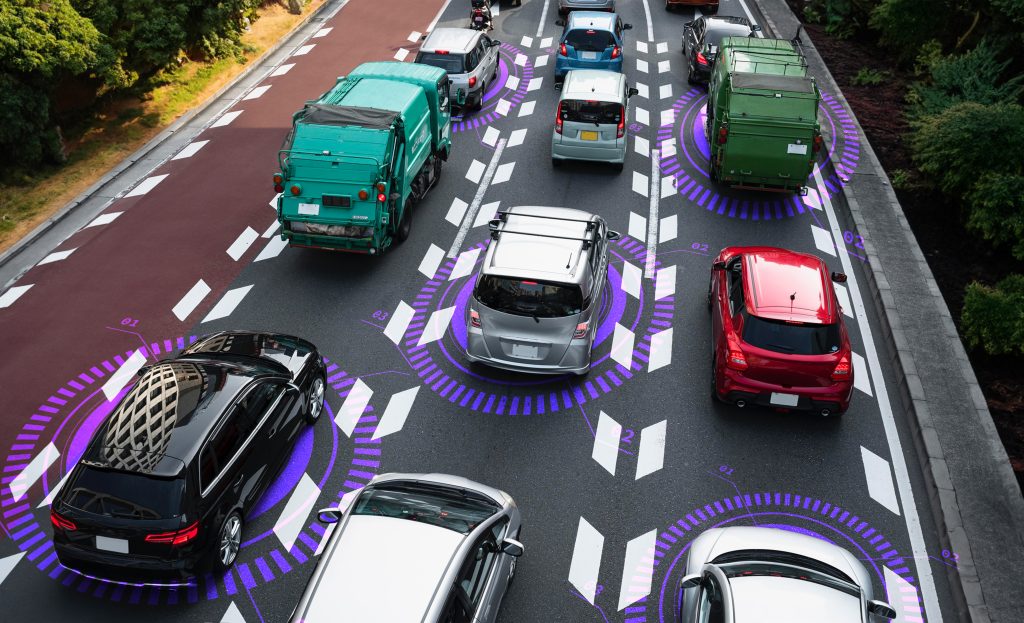Brace yourself, because the future is about to take an exhilarating turn. As artificial intelligence (AI) accelerates its progress, it is set to revolutionize the way we travel. From autonomous vehicles that navigate effortlessly through bustling streets to AI-powered traffic management systems that optimize efficiency, the potential of AI in transportation is nothing short of extraordinary. In this discussion, we will explore the transformative impact of AI on road safety, freight transportation, and even the aviation industry. Get ready to embark on a journey into a future where AI takes the wheel and transports us into a world of endless possibilities.
Self-Driving Vehicles
Self-driving vehicles, also known as autonomous cars, are revolutionizing the transportation industry by utilizing Artificial Intelligence (AI) technology to navigate and operate without human intervention. These vehicles are not just a futuristic concept anymore, as we are already seeing the deployment of autonomous taxis in cities like Tokyo. The impact of self-driving vehicles goes beyond just providing a convenient mode of public transportation. It has the potential to optimize the supply chain for goods delivery, improving logistics efficiency and reducing costs. Moreover, road safety is a major concern in the transportation industry, and autonomous cars have the potential to significantly reduce accidents by eliminating human errors and distractions. With AI-powered systems at the helm, self-driving vehicles can make real-time decisions to ensure the safety of both passengers and pedestrians. As we move towards a more connected and efficient transportation system, self-driving vehicles are at the forefront of this technological revolution, promising a future with improved road safety, optimized logistics, and seamless public transportation.
Traffic Management Optimization
As we continue to explore advancements in transportation technology, one area that holds great promise for optimizing traffic flow and reducing congestion is the field of traffic management optimization. With the integration of AI in traffic control, predictive traffic analysis, real-time traffic optimization, and intelligent traffic signals, the future of traffic management looks promising. Here’s a glimpse of what AI-assisted traffic management can bring:
- Predictive Traffic Analysis:
- Utilizing AI algorithms, traffic patterns can be analyzed and predicted based on historical and real-time data.
- This enables authorities to proactively identify congestion-prone areas and implement measures to alleviate traffic.
- Real-Time Traffic Optimization:
- AI-powered systems continuously monitor traffic conditions and adjust signal timings and routes in real-time.
- This dynamic optimization ensures efficient traffic flow and minimizes congestion.
- Intelligent Traffic Signals:
- AI enables traffic signals to adapt to changing traffic patterns and prioritize traffic based on demand.
- This reduces waiting times and improves overall traffic flow.
With AI-assisted traffic management, authorities can achieve optimal traffic flow, reduce congestion, and enhance the overall efficiency of transportation systems. By leveraging predictive analytics, real-time optimization, and intelligent traffic signals, the future of traffic management holds great promise for creating smoother and more efficient journeys.
Driver Monitoring Systems
Driver monitoring systems, powered by AI technology, enhance road safety and improve driver behavior by continuously monitoring and analyzing driver performance. These systems use AI-powered surveillance to provide real-time monitoring of drivers, allowing for immediate intervention when necessary. By analyzing driver behavior, these systems can identify signs of drowsiness, distraction, or aggressive driving, and provide alerts to the driver to prevent accidents. The use of AI in driver monitoring systems offers several safety enhancements, including accident prevention and improved driver awareness.
| AI-Powered Driver Monitoring Systems |
|---|
| • Real-time monitoring of driver behavior |
| • Analysis and detection of drowsiness and distraction |
| • Alert notifications for potential accidents |
| • Continuous surveillance for improved driver awareness |
| • Accident prevention through proactive intervention |
Driver monitoring systems play a crucial role in promoting safe driving practices and preventing accidents on the road. With the help of AI technology, these systems can analyze driver behavior in real-time, providing valuable insights into potential risks and enabling timely interventions. By enhancing driver awareness and promoting safer driving habits, AI-powered driver monitoring systems contribute to creating a safer and more efficient transportation ecosystem.
GPS Anti-Theft Technology
Enhancing vehicle security and protecting against theft, the next subtopic explores the advancements in GPS anti-theft technology in the transportation industry.
- Benefits of GPS anti-theft systems in protecting vehicles and cargo:
- Real-time tracking: GPS technology enables the continuous monitoring and tracking of vehicles, allowing for quick recovery in the event of theft.
- Enhanced security: GPS anti-theft systems provide an added layer of security by alerting authorities and owners when a vehicle is tampered with or moved without authorization.
- Prevention of theft: The presence of GPS anti-theft systems acts as a deterrent for potential thieves, significantly reducing the risk of vehicle theft.
- Integration with existing transportation infrastructure:
- Seamless integration: GPS anti-theft systems can be easily integrated with existing transportation infrastructure, such as fleet management systems and logistics platforms.
- Centralized monitoring: The integration of GPS anti-theft systems allows for centralized monitoring and control, enabling efficient management of vehicle security across a fleet.
- Streamlined operations: By integrating GPS anti-theft systems, transportation companies can streamline their operations, improve response times, and enhance overall security.
- Tracking and recovery capabilities:
- Stolen vehicle recovery: GPS anti-theft systems enable the tracking and recovery of stolen vehicles, reducing financial losses and minimizing insurance claims.
- Geo-fencing: GPS technology allows for the creation of virtual boundaries, triggering alerts when a vehicle deviates from its designated route or enters restricted areas.
- Secure cargo transportation: GPS anti-theft systems can track cargo in real-time, ensuring its security throughout the transportation process.
E-Commerce and Freight Transportation
The rise of e-commerce has significantly impacted the freight transportation industry, leading to increased demand for efficient and sustainable logistics solutions. As e-commerce continues to grow at a rapid pace, the challenges of sustainability and logistical efficiency have become more prominent. The traditional methods of freight transportation are facing pressure to adapt to the changing landscape of online shopping.
One of the key areas where AI is making a difference is in the automation of warehousing operations. With the increasing volume of e-commerce orders, warehouses need to optimize their processes to handle the higher demand. AI-powered robots and automation systems are being deployed to streamline operations, improve efficiency, and reduce errors. These technologies can significantly increase the speed and accuracy of order fulfillment, resulting in faster delivery times for customers.
Furthermore, the growth of e-commerce has also led to the need for collaborative solutions in freight transportation. Companies are realizing the benefits of working together to optimize their supply chains and reduce costs. By leveraging AI and data analytics, companies can share information and coordinate their operations more effectively, leading to improved efficiency and reduced environmental impact.
Robotics in E-Commerce Warehouses
AI-powered robotics is revolutionizing e-commerce warehouses, optimizing operations, and accelerating order fulfillment. With the advancement of technology, robotics is playing a crucial role in meeting the demands of online shopping. Here are some ways in which robotics is transforming e-commerce warehouses:
- Automated picking: AI-powered robots are equipped with advanced computer vision and machine learning algorithms to accurately identify and pick items from shelves. This reduces human errors and increases efficiency in order fulfillment.
- Warehouse optimization: Collaborative robotics systems work seamlessly with human workers to optimize warehouse layout and maximize storage capacity. Robots can efficiently move goods within the warehouse, reducing the time and effort required for inventory management.
- Robotic fulfillment: AI-powered robots are capable of autonomously packing and preparing orders for shipment. They can handle a wide range of products and adapt to changing demand patterns, ensuring faster and more accurate order fulfillment.
- AI-powered inventory management: Robotics systems integrated with AI algorithms can continuously monitor inventory levels, predict demand, and optimize stock replenishment. This helps in reducing stockouts and overstock situations, leading to improved customer satisfaction.
AI in Aviation Industry
AI is revolutionizing the aviation industry by improving flight efficiency, enhancing passenger experience, and predicting potential disruptions. In terms of aircraft maintenance, AI-powered systems are being used to monitor the condition of aircraft and predict maintenance needs, reducing the risk of unexpected breakdowns and improving overall safety. Furthermore, AI is enhancing customer service in aviation by utilizing chatbots and virtual assistants to provide personalized assistance and streamline the booking and check-in process. AI-based weather prediction for aviation is also playing a crucial role in ensuring safe and efficient flights. By analyzing vast amounts of data, AI algorithms can accurately forecast weather conditions, enabling airlines to make informed decisions and take necessary precautions to prevent delays and cancellations. Additionally, AI is being utilized in airport security to enhance the effectiveness of screening processes and detect potential threats more efficiently. Lastly, AI-enabled air traffic control systems are improving the management of air traffic, optimizing routes, and minimizing congestion, leading to safer and more efficient travel. With these advancements, AI is reshaping the aviation industry, driving innovation, and transforming the way we travel.



